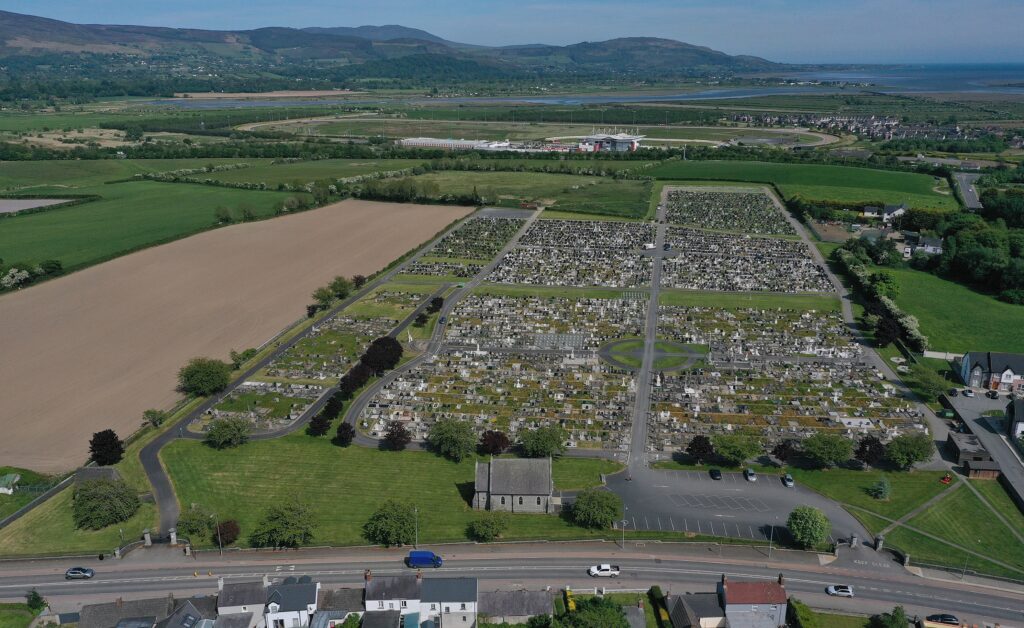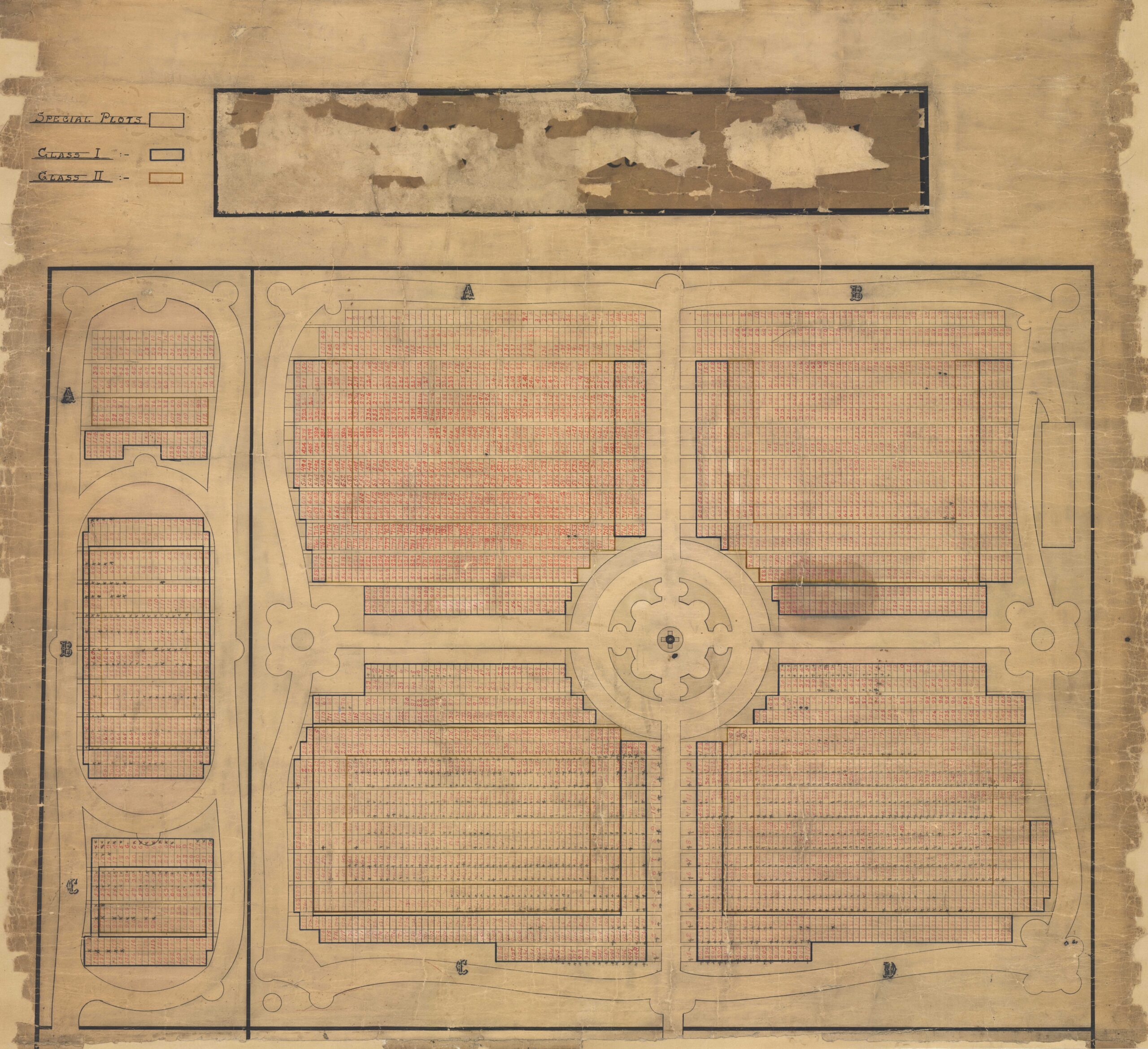By Lorraine McCann

The main collection of cemetery records held in Louth County Archives is the Dundalk Joint Burial Board collection for St Patrick’s Cemetery at Dowdallshill, Dundalk. St Patrick’s is one of two graveyards operated and maintained by Louth County Council, the other being the relatively new Newtown Cross Lane Cemetery at Newtownstalaban, Drogheda, which opened in 2007. Responsibility for St Patrick’s was inherited from the Dundalk Joint Burial Board, who managed the site from its acquisition in 1891 until the board was dissolved on 27 November 2013 under Section 230 of the Local Government Act, 2001.
St Patrick’s Cemetery first opened in 1895 and has been the final resting place for people from all walks of life for over 130 years. Its opening had long been required by the Dundalk district, as documented in the minute-books of the Dundalk Town Commissioners and Dundalk Poor Law Guardians, the urban and rural sanitary authorities for the electoral division of Dundalk, created under the Public Health (Ireland) Act, 1878. As early as April 1866, a committee was appointed to consider a strategy in relation to the crowded state of the graveyards in the town during this period, as the situation was detrimental to public health. The extant graveyards at the time included Seatown and St Nicholas Church of Ireland as well as Castletown, which was just outside the municipal boundary.
The committee on the graveyards was tasked with reporting on the best means of procuring a site for a cemetery. However, there was much debate by the guardians over which divisions of the Poor Law union would be permitted to use the cemetery, as inevitably these areas would be required to pay a rate. As the years progressed, the successful acquisition of a site ebbed and flowed. It wasn’t until 1891, after a joint petition was presented to order the formation of a united district and joint burial board, that the Local Government Board (Ireland) Provisional Order Confirmation (No. 5) Act 1891 was ultimately passed. There followed the election of the new Dundalk Joint Burial Board, consisting of elected and ex officio members of the commissioners and guardians.

Amongst the archive collection generated by the Burial Board are various financial records and registers of purchased plots holding the names and addresses of grantees (those containing the names of living individuals are closed). These registers, which were essential for the administration of the graveyard, are of interest to family historians.
The Burial Board’s surviving series of minute-books (1891–1937) document the particulars of the establishment and running of a proper burial-ground. Early minutes show that the Board promptly applied to the Commissioners of Public Works for a loan of £5,000 for the provision of a new cemetery. They subsequently passed a motion at their following meeting in October 1891 that a field in Dowdallshill, owned by Dundalk landlord Lord Roden, be ‘fixed as the site for the new burial-ground to be provided for the United District of Dundalk’.
In addition to the Board’s accounts, correspondence received and matters arising, the minutes contain a record of orders made, such as the arrangement of the graveyard into sections, the number of grave spaces, various improvements and developments, and appointments made, including those of caretaker and registrar. From its inception the cemetery served both the Catholic and Protestant communities, and we find entries relating to the needs of both denominations.
An important item in the collection is the Rules for the Regulation of the Dundalk Public Cemetery. It details 33 rules and provides the scale of charges approved by the Local Government Board in 1895. Rules helped to give order and ensured that burials were carried out at sufficient depth so as not to endanger public health. The booklet also includes the Rules and Regulations for the Regulation of Burial Grounds, issued by the Local Government Board for Ireland in 1888 (amended in 1919, 1929 and 2013). These remain the main rules for burial-grounds to this day, while the pieces of governing legislation include the aforesaid 1878 Act, the Local Government (Sanitary Services) Act, 1948, and the Local Government Act, 1994. The management of proper burial-grounds by local authorities since the 1878 legislation, along with other sanitary services, has played an important role in the development of Irish society. Dangerous outbreaks of diseases that characterised previous centuries have increasingly diminished.
The collection also contains a wonderful map of the cemetery (p. 52), showing the graveyard’s sections and a colour outline on blocks of graves, indicated by the map’s legend as special plots, class I plots and class II plots, with every grave thereon numbered. Sadly, its title, ‘St Patrick’s Cemetery, Dundalk’, has almost disappeared, with the wording’s outline now barely visible. It was drawn by James Gaskin CE, whom the board had appointed as architect in 1891. Rule II in the 1888 Regulations stipulated that a map of the burial-ground be kept ‘in some convenient place at or near the burial-ground’ and that ‘every grave-space shall be shown with its distinctive mark inscribed thereon’.
By far the most significant series of cemetery records are the burial registers. Such extant registers are of immense value to family, local, social and research historians, as they provide information on those who often do not feature in mainstream sources. Burial registers usually contain similar information, and those for St Patrick’s, which include an index of names, detail the name, age, sex, religion, occupation, condition (i.e. married or single), last place of residence and dates of death and burial of the deceased, along with the section of ground, the grave number, the signature of the person having management of the interment and the signature of the registrar. Digitised burial registers can be found on the websites of several county archive services and the first five volumes for St Patrick’s (1895–1993) are available on https://www.louthcoco.ie/en/services/archives/.
Some county archives also offer free online access to searchable databases of burials where burial registers have been transcribed. Louth County Council recently produced one for St Patrick’s Cemetery with the assistance of Jim Kerley of the Old Dundalk Society. It incorporates an interactive grave locator map and can be accessed on https://www.louthcoco.ie/en/services/archives/st-patrick-s-cemetery-database/. Here users can search over 22,000 records spanning 125 years and view corresponding grave locations, making it a valuable resource for historical and genealogical research in County Louth that can be utilised for many years to come.
Lorraine McCann is Louth County Archivist.
